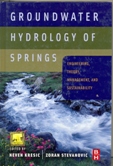
|
GROUNDWATER HYDROLOGY OF SPRINGS, INDIAN REPRINT - NEVEN KRESIC (EX) |
Author |
NEVEN KRESIC
ZORAN STEVANOVIC
|
|
Cover Price : Rs 3,995.00
|
Imprint : Butterworth/Newness
ISBN : 9789382291343
YOP : 2013
|
Binding : Hardbound
Total Pages : 592
CD : No
|
|
First utilized as a primary source of drinking water in the ancient world, springs continue to supply many of the world's cities with water. In recent years their long-term sustainability is under pressure due to an increased demand from groundwater users. Edited by two world-renowned hydrologists, Groundwater Hydrology of Springs: Engineering,Theory, Management, and Sustainability will provide civil and environmental engineers with a comprehensive reference for managing and sustaining the water quality of Springs. With contributions from experts from around the world, this book cover many of the world's largest springs, providing a unique global perspective on how engineers around the world are utilizing engineering principles for coping with problems such as mismanagement, and overexploitation and their impacts both water quantity and quality. The book will explain the theory and principles of hydrology as they apply to Springs and will provide a rare look into the engineering practices used to manage some of the most important Springs from around the world.
KEY FEATURES
-Description of the spring, the aquifer feeding it, and aquifer use.
-Latest groundwater and contaminant transport models and illustrations.
-Understanding of contamination and/or possible contamination.
Contents
1. Sustainability and management of springs
2. Types and classifications of springs
3. Recharge of springs
4. Spring discharge hydrograph
5. Modeling
6. Springwater geochemistry
7. Springwater treatment
8. Delineation of spring protection zones
9. Utilization and regulation of springs
10.Case Study Major springs of southeastern Europe and their utilization
11.Case Study Klaumlffer Spring the major spring of the Vienna water supply Austria
12.Case Study Characterization, exploitation and protection of the Malenscica karst spring Slovenia
13.Case Study Hydrogeology and exploitation of lzvarna Spring Romania
14.Case Study Intake of the Bolje Sestre karst spring for the regional water supply of the Montenegro coastal area
15.Case Study Geological and hydrogeological properties of Turkish karst and major karstic springs
16.Case Study Springs of the Zagros mountain range Iran and Iraq
17.Case Study Sheshpeer Spring Iran
18.Case Study Protection of Edwards Aquifer Springs, the United States
19.Case Study Utilization and protection of large karst springs in China
Index
|
|
 |
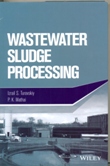
|
Wastewater Sludge Processing, Indian Reprint - Izrail S.Turovskiy (EX) |
Author |
Izrail S. Turovskiy
P.K. Mathai
|
|
Cover Price : Rs 3,495.00
|
Imprint : Wiley India
ISBN : 9788126546343
YOP : 2014
|
Binding : Hardbound
Total Pages : 366
CD : No
|
|
The processing of wastewater sludge for use or disposal has been a continuing challenge for municipal agencies. Yet, whensludge is p properly processed, the resulting nutrient-rich product-biosolids-can be a valuable resource for agriculture and other uses. Wastewater Sludge Processing brings together a wide body of knowledge from the field to examine how to effectively process sludge to reap its benefits, yet protect public health.
Presented in a format useful as both a reference for practicing environmental engineers and a textbook for graduate students, this book discusses unit operations used for processing sludge and the available methods for final disposition of the processed product. Topics discussed include sludge quantities and characteristics, thickening and dewatering, aerobic and anaerobic digestion, alkaline stabilization, composting, thermal drying and incineration, energy consumption, and the beneficial use of biosolids.
COMPREHENSIVE IN ITS COVERAGE, THE TEXT:
* Describes new and emerging technologies as well as international methods
* Compares different types of sludge processing methods
* Explains both municipal and industrial treatment technologies
Written by authors with decades of experience in the field, Wastewater Sludge Processing is an invaluable tool for anyone planning, designing, and implementing municipal wastewater sludge management projects.
Contents
Preface
Abouth the Authors
Chapter 1. Introduction.
Chapter 2. Sludge Quantities and Characteristics.
Chapter 3. Thickening and Dewatering.
Chapter 4. Aerobic Digestion.
Chapter 5. Anaerobic Digestion.
Chapter 6. Alkaline Stabilization.
Chapter 7. Composting.
Chapter 8. Thermal Drying and Incineration.
Chapter 9. Comparison of Energy Consumption.
Chapter 10. Beneficial Use of Biosolids.
Appendix Units of Measure
Index
ZRAIL S. TUROVSKIY is a wastewater and biosolids consultant in Jacksonville, Florida. He received a BS degree in civil engineering from Civil Engineering Institute, St. Petersburg, Russia; an MS degree in sanitary engineering from Civil Engineering Institute, Moscow, Russia; and a DSc degree in environmental engineering from Municipal Academy, Moscow. He has more than fifty years of experience in environmental engineering, including time as head of the All-Union Research Institute of Water Supply, Sewage Systems, and Hydrotechnical Structures in Moscow. Dr. Turovskiy has patentsin Russia, France, Germany, Italy, Finland, and the United States. He has also authored or coauthored more than 200technical publications including eight books.
P. K. MATHAI is a senior project manager and Associate Fellow in environmental engineering with Jacobs Civil, Inc. in St. Louis, Missouri. He received a BS degree in civil engineering from University of Kerala, India, and an MS degree in environmental engineering from University of Dayton, Ohio. He has over thirty years of wide-ranging experience in environmental engineering and has been involved in the planning, design, and technical review of over sixty wastewater treatment plants and sludge processing facilities. He is a registered professional engineer in Missouri, Illinois, Ohio, Kentucky, and Maryland.
|
|
 |
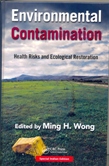
|
Environmental Contamination - Ming H. Wong |
|
|
Cover Price : Rs 4,995.00
|
Imprint : CRC Press
ISBN : 9781439892381
YOP : 2015
|
Binding : Hardbound
Total Pages : 520
CD : No
|
|
Bringing together the research of 62 distinguished scientists in one volume, Environmental Contamination: Health Risks and Ecological Restoration offers a comprehensive view of the remediation of contaminated land. A one-stop resource, it covers historical and emerging contaminants, the issues of bioavailability of chemicals and their associated human health risks, and the latest remediation technologies. The book also contains numerous case studies, many of them drawn from the Asia-Pacific region, that look at the effects of rapid industrialization. The chapters are inspired by presentations and discussions held during the 2010 Croucher Advanced Study Institute workshop, entitled Remediation of Contaminated Land—Bioavailability and Health Risk.
With the speed and scale of recent socioeconomic development, particularly in regions with less stringent environmental regulations, it is evident that various industrial activities have given rise to tremendous environmental degradation and severe health problems. The book begins with a description of current problems and future trends of pollutants, as well as their impact on the environment and human health. It then focuses on emerging contaminants, such as flame retardants and electronic waste. The book also examines research on environmentally friendly and sustainable solutions to remediate contaminated lands, exploring cutting-edge bioremediation and phytoremediation technologies. Chapters discuss arsenic biomethylation, copper homeostasis, microbial transformation of phthalate esters, the potential function of paddy fields in phytoremediation, the use of constructed wetlands for pollution control, phytostabilization of arsenic-contaminated sites, and more.
This timely book provides readers with a highly focused reference on some of the most urgent environmental and health issues and research topics. These include e-waste recycling and arsenic and heavy metal contamination of rice—issues that are relevant for many countries around the world.
Preface
Editor
Contributors
Environmental Contamination: Health Risks and Ecological Restoration
Ming Hung Wong
Part I Health Impacts and Risk Assessment
Health Impacts of Toxic Chemicals in the Pearl River Delta: The Need for Healthcare Reform?
Paul K.L. Lam and Ming Hung Wong
Heavy Metal Overloads and Autism in Children from Mainland China and Hong Kong: A Preliminary Study
Lillian Y.Y. Ko, Yan Yan Qin, and Ming Hung Wong
Endocrine-Disrupting Contaminants and Their Effects on Reproductive and Developmental Health
Chris K.C. Wong
Assessing Health Risks from Arsenic Intake by Residents in Cambodia
Suthipong Sthiannopkao, Kongkea Phan, Kyoung-Woong Kim, and Ming Hung Wong
Pragmatic Approach for Health Risk Assessment of Bauxite Tailing Waste Materials
Jack C. Ng, Jian Ping Wang, Cheng Peng, and Guanyu Guan
Part II Emerging Chemicals and Electronic Waste
Polybrominated Diphenyl Ethers in China: Sources, Trends, and Their Adverse Impacts on Human Health
Gene J.S. Zheng, Liping Jiao, Anna O.W. Leung, Yeqing Huang, Tingting You, and Ming Hung Wong
Removal of Persistent Organic Pollutants and Compounds of Emerging Concern in Public-Owned Sewage Treatment Works: A Review
Ming Man and Ming Hung Wong
Inverse Relationship between Urinary Retinol-Binding Protein, Beta-2-Microglobulin, and Blood Manganese Levels in School-Age Children from an E-Waste Recycling Town
Jinrong Huang, Xijin Xu, Guina Zheng, Kusheng Wu, Yongyong Guo, Junxiao Liu, Hao Ban, Weitang Liao, Wei Liu, Hui Yang, Qiongna Xiao, Yuanping Wang, and Xia Huo
Mitigating Environmental and Health Risks Associated with Uncontrolled Recycling of Electronic Waste: Are International and National Regulations Effective?
Ming Hung Wong, Anna O.W. Leung, Shengchun Wu, Clement K.M. Leung, and Ravi Naidu
Decision-Making Support Tools for Managing Electronic Waste
Peeranart Kiddee, Ravi Naidu, and Ming Hung Wong
Part III Ecological Restoration of Contaminated Sites: Bioremediation
Biomethylation of Arsenic in Contaminated Soils
Richard P. Dick, Qin Wu, and Nicholas T. Basta
Handling Copper: A Paradigm for the Mechanisms of Metal Ion Homeostasis
Kathryn A. Gogolin and Marinus Pilon
Plant Selenium Metabolism: Genetic Manipulation, Phytotechnological Applications, and Ecological Implications
Elizabeth A.H. Pilon-Smits
Microbial Transformation of Phthalate Esters: Diversity of Hydrolytic Esterases
Ji-Dong Gu and Yuping Wang
Mixed Contamination of Polyaromatic Hydrocarbons and Metals at Manufactured Gas Plant Sites: Toxicity and Implications to Bioremediation
Palanisami Thavamani, Mallavarapu Megharaj, Kadiyala Venkateswarlu, and Ravi Naidu
Part IV Ecological Restoration of Contaminated Sites: Phytoremediation
Toxicity and Bioavailability of Heavy Metals and Hydrocarbons in Mangrove Wetlands and Their Remediation
Lin Ke and Nora F.Y. Tam
Origin of Paddy Fields and Functions for Environmental Remediation in the Urbanized Areas of Yangtze River Delta
Zhihong Cao
Remediation and Reuse of Stormwater by Ecotechnology
R. Brian E. Shutes, D. Michael Revitt, J. Bryan Ellis, and Lian Lundy
Phytostabilization for Sustainable End-Use of Arsenic-Rich Mine Tailings in the Victorian Goldfields, Australia
Augustine Doronila, Ron T. Watkins, and Alan J.M. Baker
Field Application of the Stabilization Process for Arsenic-Contaminated Soil
Myoung-Soo Ko, Ki-Rak Kim, and Kyoung-Woong Kim
Bioavailability of Metals and Arsenic on Brownfield Land: Remediation or Natural Attenuation for Risk Minimization?
Nicholas M. Dickinson, William Hartley, Amanda Black, and Cameron S. Crook
Index
|
|
 |
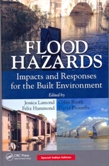
|
Flood Hazards - Jessica Lamond |
Author |
Jessica Lamond
Colin Booth
Felix Hammond
David Proverbs
|
|
Cover Price : Rs 4,995.00
|
Imprint : CRC Press
ISBN : 9781439826256
YOP : 2015
|
Binding : Hardbound
Total Pages : 380
CD : No
|
|
As major flooding events around the world show, the impact of flooding on the built environment can cause widespread chaos. These flood events form part of a wider pattern of increasing flood frequency coupled with increased vulnerability of the built environment to flood hazard. Flood risk can unite or divide communities and the responses to potential risk can range from denial to perfect adaptation.
Drawing on the experience of communities and experts, Flood Hazards: Impacts and Responses for the Built Environment offers guidance on managing urban flooding and flood risk. It brings together a diversity of viewpoints and experiences on flood impacts and responses from leading academics, flood restoration specialists, emergency responders, architects, planning consultants, insurers, policymakers, and community representatives. By including the perspective of the community and the views of households and businesses at risk, this volume makes a unique contribution to the literature on flood management
The chapter organization loosely corresponds to the phases of the disaster management cycle, covering emergency preparation and response; recovery, repair, and reconstruction; and mitigation and adaptation. Contributors examine the types of impacts and discuss forecasting and emergency warning. They describe processes and good practice in recovery of flood-damaged property from the perspectives of the insurance industry, restorers, and loss adjusters. The book also deals with business continuity, land-use planning, property-level and infrastructure protection, and urban drainage, looking at the regulation and design of the built environment as one way to reduce risk. A section on community response to flooding sheds light on the experiences of flood-affected families.
Written for students, practitioners, and researchers in flood risk management, as well as for professionals who may encounter flood-related issues in the course of their work, this cross-disciplinary book makes a valuable contribution towards designing a future built environment that is more resilient to flood risk
Contents
Preface
About the Contributors
List of Contributors
- Flooding in the Built Environment: Changing Risk and an Overview of Impacts; Jessica E. Lamond, David G. Proverbs, Colin A. Booth, and Felix N. Hammond
Section I Impacts, Preparedness, and Emergency Response
- State of the Art of Flood Forecasting: From Deterministic to Probabilistic Approaches; Jutta Thielen, Florian Pappenberger, Peter Salamon, Konrad Bogner, Peter Burek, and Ad de Roo
- Flood Warning and Incident Management; Katherine Evans
- Impacts of Flooding in the Built Environment; Derek Bell
- Health Impacts of Flooding; Harriet Caldin and Virginia Murray
- The UK Sewer Network: Perceptions of its Condition and Role in Flood Risk; Lee French, Victor Samwinga, and David G. Proverbs
Section II Recovery, Repair, and Reconstruction
- Flood Insurance in the United Kingdom: The Association of British Insurers’ View; Swenja Surminski
- A Practical Guide to Drying a Water-Damaged Dwelling; Bill Lakin and David G. Proverbs
- The Art of Reinstatement; Roger Woodhead
- The Development of Standards in Flood Damage Repairs: Lessons to be Learned from the United Kingdom Example; Tony Boobier
- Resilient Repair Strategy; Richard Ayton-Robinson
Section III Mitigation and Adaptation to Flood Risk
- International Historical, Political, Economic, Social, and Engineering Responses to Flood Risk;David Crichton
- Risk Management, Adaptation, and Monetary Aspects; Annegret H. Thieken, Holger Cammerer, and Clemens Pfurtscheller
- Blue Space Thinking; Robert Barker
- Adapting and Mitigating Floods Using Sustainable Urban Drainage Systems (SUDS); Susanne M. Charlesworth and Frank Warwick
- Land Use Planning Issues; Bill Finlinson
- Flood Resilience for Critical Infrastructure and Services; Ben Kidd
- Protection and Performance of Flooded Buildings; Mike Johnson
- Impacts of Flood Hazards on Small and Medium-Sized Companies: Strategies for Property-Level Protection and Business Continuity; Bingunath Ingirige and Gayan Wedawatta
Section IV The Community Perspective
- Living with Flood: Understanding Residents’ Experiences of Recovery; Rebecca Whittle and Will Medd
- Property-Level Flood Protection: Case Studies of Successful Schemes; Mary Dhonau and Jessica E. Lamond
- Improving Community Resilience: Education, Empowerment, or Encouragement? Carly B. Rose, David G. Proverbs, Ken I. Manktelow, and Colin A. Booth
- Financial Implications of Flooding and the Risk of Flooding on Households; Jessica E. Lamond
- Why Most "At-Risk" Homeowners Do Not Protect Their Homes from Flooding; Tim Harries
- Exploring the Effect of Perceptions of Social Responsibility on Community Resilience to Flooding; Aaron Mullins and Robby Soetanto
- Lessons for the Future; Felix N. Hammond, Colin A. Booth, Jessica E. Lamond, and David G. Proverbs
Index
|
|
 |
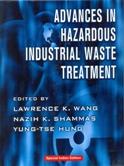
|
Advances in Hazardous Industrial Waste Treatment - Lawrence K.Wang |
Author |
Lawrence K. Wang
Nazih K. Shammas
Yung-Tse Hung
|
|
Cover Price : Rs 4,995.00
|
Imprint : CRC Press
ISBN : 9781420072303
YOP : 2015
|
Binding : Hardbound
Total Pages : 580
CD : No
|
|
As the global nature of pollution becomes increasingly obvious, successful hazardous waste treatment programs must take a total environmental control approach that encompasses all areas of pollution control. With its focus on new developments in innovative and alternative environmental technology, design criteria, effluent standards, managerial decision methodology, and regional and global environmental conservation, Advance in Hazardous Industrial Waste Treatment provides the widest possible coverage drawn from the full spectrum of experts in the field
Features
- covers environmental pollution sources, waste characteristics, control technologies, management strategies, facility innovations, process alternatives, costs, case histories, and effluent standards in industry.
- Delineates methods, technologies, and the regional and global effects of important pollution control practices.
- Highlight innovative and alternative technologies, design criteria, managerial decision making, and regional and global environmental conservation specific to industrial hazardous wastes.
- Includes examples of major industrial hazardous pollutants that have significant effects on the environment
- Provides extensive bibliographies for each industrial waste treatment practice that point to sources of further information.
Contents
Characteristics of Industrial Hazardous Wastes. Legislation and Regulations of Industrial Hazardous Wastes.Soil Remediation. Recycling and Disposal of Electrical and Electronic Wastes. Remediation of MTBE and Other Fuel Oxygenates. Remediation of Sites Contaminated by Hazardous Wastes. Enzymatic Treatment of Pentachlorophenol Containing Wastes. Treatment of Landfill Wastes. Alternative ET Landfill Cover. Combined Landfill Leachate Treatment and Bioremediation. Remediation of Sites Contaminated by Underground Storage Tank Releases. Selection and Applications of Phytoremediation. Hazardous Waste Deep-Well Injection. Treatment of Hospital Wastes (optional).
Since the field of industrial hazardous waste treatment is very broad, no one can claim to be an expert in all industries. Therefore, editors Wang, Shammas, and Hung draw on collective contributions that reflect the depth and breadth of the field, making the resulting handbook the best available reference on chemical and environmental engineering for industrial hazardous waste treatment. They provide technical and economical information on the development of the most feasible total environmental control programs that can benefit industries and local municipalities.
|
|
 |
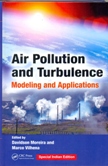
|
Air Pollution and Turbulence - Davidson Moreira |
Author |
Davidson Moreira
Marco Vilhena
|
|
Cover Price : Rs 3,995.00
|
Imprint : CRC Press
ISBN : 9781439811443
YOP : 2015
|
Binding : Hardbound
Total Pages : 346
CD : No
|
|
Since its discovery in early 1900, turbulence has been an interesting and complex area of study. Written by international experts, Air Pollution and Turbulence: Modeling and Applications presents advanced techniques for modeling turbulence, with a special focus on air pollution applications, including pollutant dispersion and inverse problems. The book’s foreword was written by specialists in the field, including the Professor Sergej Zilitinkevich. Offering innovative atmospheric mathematical modeling methods, which can also be applied to other disciplines, the book includes:
• Discussions on the effects of soot and diesel particulates on building surfaces and human health
• Observational studies of convective Atmospheric Boundary Layer (ABL) over pastures and forests in Amazonia
• Theoretical studies of turbulence and turbulent transport modeling of contaminants during the decaying of a ABL convective
• The parameterization of convective turbulence and clouds in atmospheric models based on the combination of the eddy-diffusivity and mass-flux approaches
• Analytical solutions to the advection-diffusion equation and analytical models for air pollution, including those for low wind conditions
• Analytical solutions to the advection-diffusion equation using the Generalized Integral Laplace Transform Technique (GILTT) and the decomposition method
• Lagrangian stochastic dispersion models with applications for airborne dispersion in the ABL
• Atmospheric dispersion with Large Eddy Simulation (LES) using the Lagrangian and Eulerian approaches
• Modeling of photochemical air pollution for better air quality management
• Analysis of the transport of a trace gas (CO2) at the global scale and overviews of the inverse-problem techniques for deducing emissions from known concentrations
The book provides a solid theoretical understanding of turbulence and includes cases studies that illustrate subjects related to environmental sciences and environmental modeling. It reflects and summarizes recent developments in key areas of modeling atmospheric turbulence and air pollution. It pulls together information on techniques and methods used on turbulence, air pollution, and applications. While these topics are often covered separately, this book’s combined coverage of all three areas sets it apart.
Contents
Foreword
Preface
Editors
Contributors
1. Deposition, Transformation, and Remobilization of Soot and Diesel Particulates on Building Surfaces, P. Brimblecombe and C.M. Grossi
2. Atmospheric Boundary Layer: Concepts and Measurements, G. Fisch
3. Turbulence and Dispersion of Contaminants in the Planetary Boundary Layer, G.A. Degrazia, A. Gledson Oliveira Goulart, and D.R. Roberti
4. Parameterization of Convective Boundary Layer Turbulence and Clouds in Atmospheric Models, P.M.M. Soares, J. Teixeira, and P.M.A. Miranda
5. Mathematical Air Pollution Models: Eulerian Models, T. Tirabassi
6. Analytical Models for the Dispersion of Pollutants in Low Wind Conditions, P. Kumar and M. Sharan
7. On the GILTT Formulation for Pollutant Dispersion Simulation in the Atmospheric Boundary Layer, D.M. Moreira, M. Túllio M. B. de Vilhena, and D. Buske
8. An Outline of Lagrangian Stochastic Dispersion Models, D. Anfossi and S.T. Castelli
9. Atmospheric Dispersion with a Large-Eddy Simulation: Eulerian and Lagrangian Perspectives, U. Rizza, G. Gioia, G. Lacorata, C. Mangia, and G.P. Marra
10. Photochemical Air Pollution Modeling: Toward Better Air Quality Management, C. Borrego, A.I. Miranda, and J. Ferreira
11. Inversion of Atmospheric CO2 Concentrations, I.G. Enting
Index
|
|
 |
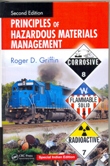
|
Principles of Hazardous Materials Management, 2nd Ed - Roger D.Griffin |
|
|
Cover Price : Rs 3,995.00
|
Imprint : CRC Press
ISBN : 9781420089707
YOP : 2015
|
Binding : Hardbound
Total Pages : 260
CD : No
|
|
Since the publication of the first edition of this volume in 1988, we have made great strides in reducing the amount of toxic waste that threatens our water, soil, and air. A greater acceptance of clean fuels and clean technologies, along with increased public awareness of environmental health hazards has given us greater optimism about the future of our planet. While few environmental threats can ever be completely eradicated, Principles of Hazardous Materials Management, Second Edition provides a framework for understanding the nature of hazardous materials and how the risks from such materials may be reduced.
This long-awaited second edition updates and expands upon the topics in the bestselling first edition. The text begins with an introduction to hazardous materials, providing historical insight into toxins past and present. The book then explores the health effects of hazardous materials, discusses risk assessment, and profiles toxins in the air, soil, and water. The author examines the transportation and management of hazardous materials, defines waste characterization and analytical methods, and investigates waste treatment and disposal. Appendices contain the latest governmental regulations and a useful glossary.
New to the Second Edition:
• Expanded information and new technologies for groundwater remediation
• New material on transportation and hazmat incidents
• More emphasis on proactive management as a technique for reducing hazardous waste generation
• Greater focus on the epidemiological model
This volume provides the scientific background required to gain a working knowledge of toxic and hazardous substances. Comprehensive in scope yet concise enough to appeal to a wide range of professionals, it presents sufficient detail to ensure a firm understanding of the myriad concepts involved in hazardous materials management and how they relate to one another.
Contents
Preface to the Second Edition
Preface to the First Edition
Acknowledgements
The Author
Introduction to Hazardous Materials
Hazard Defined
Ancient Hazards
The Industrial Age
The Recent Past
Toxicology and Health Effects of Hazardous Materials
Introduction
Routes of Exposure
Body Response to Toxic Chemicals
Varieties of Toxic and Hazardous Effects
Specific Contaminant Effects
Dose–Response Relationships
Allowable Exposure Limits
Time Effects and Sensitivities
Sources of Health Effects Information
Risks and Risk Assessment
Introduction
Types of Risks
The Risk Assessment Process
Uncertainties in Risk Assessments
California Approaches
Criteria for Health Impact and Acceptable Risks
Screening Level Calculations
Risk Management
Air Pollution and Air Toxics
Introduction
Classifications and Sources
Direct Evaporative Emissions
Fugitive Emissions
Waste-Related Air Toxic Emissions
Treatment-Related Emissions
Regulatory Approaches
Hazardous Air Emission Trends
Soils and Groundwater
Introduction
Principles of Hydrogeology
Groundwater Movement
Contamination in Groundwater
Mitigation and Treatment
Treatment Approaches
Biological Treatment Methods
Physical Treatment Methods
Chemical Treatment Methods
Combination Systems
Natural Methods and Attenuation
Transportation of Hazardous Materials
Introduction
Laws Involved in Hazardous Materials Transportation
Hazardous Waste Transportation Regulations
Key Elements
Practical Aspects of Hazardous Materials Transportation
Trends in Transportation Incidents
Management of Hazardous Materials
Introduction
Proactive Hazardous Materials Management
General Considerations
A Specific Management Approach: The Aerospace Industry
Hazardous Materials Planning for the Future
Proactive Emergency Planning
Waste Characterization and Analytical Methods
Introduction
Representative Sampling
EPA Reference Methods
Sampling and Handling
Units of Measurement and Physical and Chemical Properties
Fundamentals of Chemistry for Sample Analysis
Matrices and Detection Limits
Analytical Methods and Techniques
Waste Treatment and Disposal
Introduction
Materials Recovery
Basic Treatment Principles
Treatment Classes
Ultimate Residuals Management
Appendix A: Federal Regulatory Approaches
Appendix B: California Approaches
Appendix C: Hazardous Materials Definitions
Index
|
|
 |
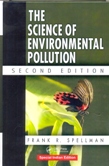
|
Science of Environmental Pollution, 2nd Ed - Frank R. Spellman |
|
|
Cover Price : Rs 4,995.00
|
Imprint : CRC Press
ISBN : 9781439813027
YOP : 2015
|
Binding : Hardbound
Total Pages : 512
CD : No
|
|
Hailed on its first publication as a masterly addition to the three-volume environmental series that also includes The Science of Water and The Science of Air, The Science of Environmental Pollution, Second Edition successfully completes the process of bringing this series into the twenty-first century. This new edition continues to ask the same questions about environmental pollution: What is it? What is its impact? What are the causes and how can we mitigate them? But more than this, the second edition stimulates new ways to think about the issues and their possible solutions.
Simply put, studying pollution without science is analogous to attempting to cook without being able to read a recipe, measure ingredients correctly, or monitor the progress of that which is cooking. Conversely, studying pollution through science affords the opportunity to maintain a healthful, life-sustaining environment. This second edition of a bestseller presents common-sense approaches and practical examples based on scientific principles, models, and observations, but keeps the text lively and understandable to scientists and non-scientists alike.
The Second Edition contains:
-Completely revised and updated information in every chapter
-New material on pharmaceuticals in water
-New material on water scarcity
Environmental issues continue to attract attention at all levels. Some sources say that pollution is the direct cause of climate change; others deny that the possibility even exists. This text sorts through the hyperbole, providing concepts and guidelines that not only aid in understanding the issues, but equip you with the scientific rationale required to make informed decisions.
Contents
Preface
Author
Introduction
Pollution: What Is It?
Introduction
Pollution Defined
Pollution: Effects Often Easy to See, Feel, Taste, or Smell
Pollution and Environmental Science/Health
Environmental Pollution and Technology: The Connection
Science and Technology Offer Solutions
The Bottom Line
Discussion Questions
References and Recommended Reading
Pollution Science Fundamentals
Introduction
Biogeochemical Cycles
Energy Flow through an Ecosystem and the Biosphere
Units of Measurement
The Bottom Line
Discussion Questions
References and Recommended Reading
Global Pollution: The Problem
Introduction
Global Interdependence
Global Pollution Problems: Causal Factors
Pollution and Global Environmental Degradation
So, What Is the Answer?
Discussion Questions
References and Recommended Readings
Sources of Pollution
A Historical Perspective
Introduction
Natural Pollutants
Pollutant Terminology
Soil, Water, and Air Pollution: The Interface
Discussion Questions
References and Recommended Reading
Air
Air
Introduction
All About Air
The Components of Air: Characteristics and Properties
Air for Combustion
Air for Power
Stratification of the Atmosphere
Physical Properties and Dynamics of Air
Gas Laws
Gas Conversions
Gas Velocity
Gas Stream Treatment (Residence) Time
Gas Density
Heat Capacity and Enthalpy
Heat and Energy in the Atmosphere
Adiabatic Lapse Rate
Viscosity
Flow Characteristics
Particle Physics
Characteristics of Particles
Particle Formation
Collection Mechanisms
Atmospheric Dispersion, Transformation, and Deposition
The Bottom Line
Discussion Questions
References and Recommended Reading
Air Pollution
Yurk and Smilodon
Introduction
Problems of Atmospheric Pollution
The Bottom Line
Discussion Questions
References and Recommended Readings
Air Pollution Remediation
Introduction
Clearing the Air
Air Pollution Control: Choices
Air Pollution Control Equipment and Systems
Removal of Dry Particulate Matter
Removal of Gaseous Pollutants: Stationary Sources
Removal of Gaseous Pollutants: Mobile Sources
The Bottom Line
Discussion Questions
References and Recommended Reading
Water
Water
Water: Earth’s Blood
Water: Facts and Prose
Water: The Basics
How Special, Strange, and Different Is Water?
Characteristics of Water
Water’s Physical Properties
Capillary Action
The Water Cycle
Specific Water Movements
Q and Q Factors
Sources of Water
Watershed Protection
Potable Water Source
Surface Water
Groundwater Supply
Well Systems
Water Use
The Bottom Line
Discussion Questions
References and Recommended Reading
Water Pollution
Case Study 9.1. Chesapeake Bay
Introduction
Surface Water
Setting the Stage
Surface Water Pollutants
Groundwater Pollution
Wetlands
The Bottom Line on Surface Water and Groundwater Pollution
Discussion Questions
References and Recommended Reading
Water Pollution: Remediation
Historical Prospective
Effect of Regulations on Preventing Water Pollution
A Sherlock Holmes at the Pump
Water Treatment
Wastewater Treatment
Thermal Pollution Treatment
Pollution Control Technology: Underground Storage Tanks
Pollution Control Technology: Groundwater Remediation
The Bottom Line
Discussion Questions
References and Recommended Reading
Soil
Soil Basics
Introduction
Soil: What Is It?
Key Terms Defined
All About Soil
Functions of Soil
Soil Basics
Soil Formation
Soil Characterization
Soil Mechanics and Physics
Soil Chemistry
Solid Wastes
The Bottom Line
Discussion Questions
References and Recommended Reading
Soil Pollution
Clean Soil
Soil Pollutants: Transport Mechanisms Affecting Flow Regime
The Basics of Soil Pollution
Industrial Practices and Soil Contamination
Hazardous Substances
Hazardous Wastes
Hazardous Waste Legislation
The Bottom Line
Discussion Questions
References and Recommended Reading
Soil Pollution Remediation
Introduction
USTs: The Problem
Risk Assessment
Exposure Pathways
Remediation of UST-Contaminated Soils
Economic Outlook
Animal Feeding Operations and Animal Waste Treatment
Waste Control Technology
Ultimate Disposal
Green Remediation
The Bottom Line
Discussion Questions
References and Recommended Reading
Pollution and the 21st Century
Glossary
Index
|
|
 |
|